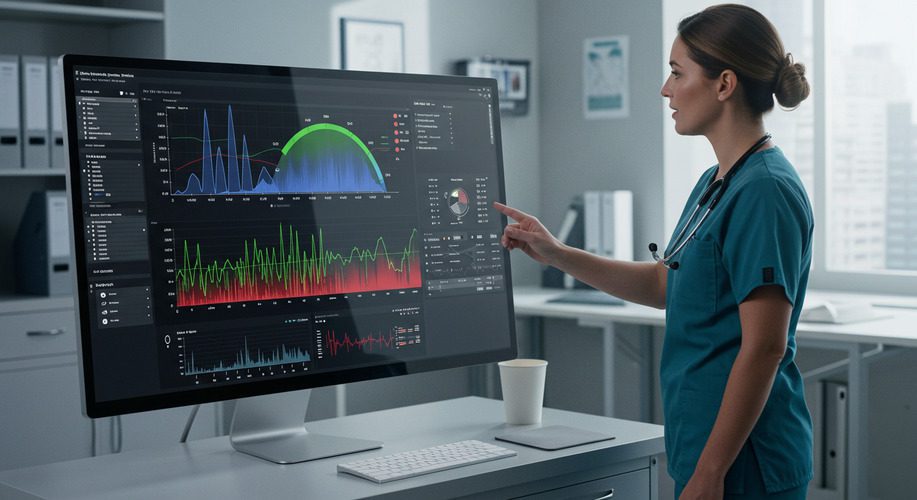Real-time data, predictive analytics empowers Software as a Medical Device (SaMD) to transform healthcare delivery. This guide explores the benefits, applications, and strategies for implementing predictive analytics in your SaMD solutions.
1. Why Predictive Analytics is Critical for SaMD
1. Enabling Proactive Healthcare
- Predictive analytics helps identify potential health issues before they escalate, enabling preventive care and reducing hospitalizations.
2. Personalizing Treatment Plans
- By analyzing patient-specific data, predictive models tailor treatments to individual needs, improving outcomes and patient satisfaction.
3. Supporting Clinical Decision-Making
- Provides clinicians with actionable insights to make more informed, data-driven decisions.
Related: Implementing Real-Time Data Analytics in SaMD Solutions
2. Key Applications of Predictive Analytics in SaMD
1. Chronic Disease Management
- Monitors trends in patient data to predict disease progression and recommend timely interventions.
- Example: Predicting blood glucose fluctuations for diabetes management.
2. Early Diagnosis and Screening
- Analyzes patterns in medical imaging or laboratory results to detect conditions like cancer or heart disease at earlier stages.
3. Patient Monitoring and Alerts
- Continuously tracks vitals and sends alerts to providers or patients when abnormal patterns are detected.
- Example: Identifying arrhythmias in real-time for patients with heart conditions.
Related: Advanced AI/ML Models for SaMD: Risks and Rewards
3. Technical Considerations for Implementing Predictive Analytics
1. Data Collection and Quality
- Use diverse, high-quality datasets to train algorithms and minimize bias.
- Ensure continuous data streams from IoT devices and wearables are accurate and secure.
2. Algorithm Transparency
- Develop interpretable models to ensure clinicians and patients can understand and trust predictions.
- Document decision-making processes for regulatory compliance.
3. Real-Time Processing
- Employ scalable cloud platforms to process large volumes of data quickly.
- Use edge computing for low-latency analytics in IoT-connected devices.
Related: Harnessing IoT for Improved Compliance and Monitoring in SaMD
4. Challenges and Solutions
1. Regulatory Complexity
- Challenge: Aligning predictive models with evolving regulatory frameworks.
- Solution: Engage with regulatory bodies early and integrate compliance measures during development.
2. Data Privacy and Security
- Challenge: Managing sensitive patient data without compromising privacy.
- Solution: Use advanced encryption methods and anonymization techniques to protect data.
3. Bias in Predictions
- Challenge: Algorithm bias can lead to inequitable outcomes.
- Solution: Use diverse datasets and perform regular audits to identify and mitigate bias.
Related: Navigating FDA’s Proposed AI/ML Framework for SaMD
5. Best Practices for Implementation
1. Focus on Clinically Relevant Insights
- Design predictive models that address real clinical needs and integrate seamlessly into existing workflows.
2. Validate and Monitor Algorithms
- Conduct rigorous validation using real-world evidence (RWE) to ensure accuracy and reliability.
- Continuously monitor algorithm performance post-deployment to maintain effectiveness.
3. Engage Stakeholders
- Collaborate with clinicians, regulatory experts, and end-users to refine predictive models and ensure usability.
Related: How to Conduct Post-Market Surveillance for SaMD (Advanced Guide)
6. Future Directions for Predictive Analytics in SaMD
1. Integration with AI and Machine Learning
- AI/ML advancements will enable even more precise and dynamic predictive models.
2. Expansion of IoT Ecosystems
- IoT devices will provide richer data streams for predictive analytics, enhancing accuracy and scope.
3. Global Health Applications
- Predictive analytics will play a vital role in addressing global health challenges, such as tracking disease outbreaks.
Conclusion
Predictive analytics is transforming SaMD by enabling proactive, personalized, and data-driven healthcare solutions. By leveraging advanced technologies and adhering to best practices, you can create SaMD solutions that anticipate patient needs, improve outcomes, and drive innovation in the MedTech landscape.
For further insights, explore related articles:
Start integrating predictive analytics into your SaMD solutions today to lead the way in proactive healthcare.





